Stead Air Force Base Student Study Guide 140004-3 (Academic)
February 1963
For Instructional Purposes Only

Stead Air Force Base Student Study Guide 140004-3 (Academic)
February 1963
For Instructional Purposes Only

Annotations by Joseph R. Svinth. Copyright © EJMAS 2000.
Introduction
During World War II, US bomber groups in Europe suffered more combat casualties than did the US Marine Corps in the Pacific. Many of the lost airmen ended up in German POW camps, and as a result a generation of US Air Force officers were firm believers in tough, realistic escape and evasion training. So, when Lt. General Curtis LeMay took over the Strategic Air Command (SAC) in 1949, he decided to implement a physical training program for bomber crews that included a Japanese-designed mix of Kodokan judo, Shotokan karate, and Tomiki aikido.
In 1952, Air Training Command (ATC) took over the Strategic Air Command program, and until 1966, Stead Air Force Base in Reno, Nevada, was the Air Force's Combative Measures (Judo) course. The US Air Force Survival School history acknowledges that the "Combative Measures course was extremely successful but, in an effort to reduce aircrew training time [during the Vietnam buildup] and to reduce spending, it was dropped from the [Survival School] course."
Thirty-five years later, while there are many Americans who learned judo from former Air Force judoka, there is virtually no institutional memory of the program within the active Air Force or its historical branch. EJMAS is therefore proud to remedy this omission by reprinting a number of manuals obtained from W. Stewart Bush, who was a US Air Force judo instructor at McChord Air Force Base, Washington, during the 1950s and 1960s.
A theme repeated several times in this document is that "In every situation, it is most advisable to get your opponent off balance before going on the offensive." This is contradictory to what is often taught in military-style martial art classes today. Also, a caveat: as an instructor's manual, it is assumed that the instructor knows how to teach the hands-on portions of the training. As a result, why is stressed more than how. How is discussed in greater detail, however, in manuals to be added to this series in coming months.
Finally, for additional historical background, try:
Presentation of Air Crew Self-Defense Techniques or Unarmed Combative Measures Training is another step the U.S. Air Force has taken to take care of its own. The crew member plays a valuable role in the defense of our nation's heritage, and he, therefore, deserves every right to continue to enjoy this heritage. To preserve this intangible property our flyers must be able to go on to an enemy target and return. To accomplish this, our country not only provides the finest equipment available for accomplishment of the primary mission, it also provides the aircrewman with extensive knowledge of proven methods of survival and the equipment to enable him to effect a safe return in the event an emergency puts him into a survival or evasion situation.
What with training in survival on both land and water, escape and evasion, survival weapons, resistance, and unarmed combative measures, together with the maintenance of a capable rescue service, a flyer can rest assured that every means has been taken to provide for his return.
Unarmed combative measures may be considered a "last resort" method of survival. When all else fails, unarmed combative measures can be relied on as one more "ace in the hole" to call upon. It would be good to be able to say "I won't ever have to use that," but it is much better to know that you are capable of using this "ace in the hole" if the need arises. (See Figure 1.)
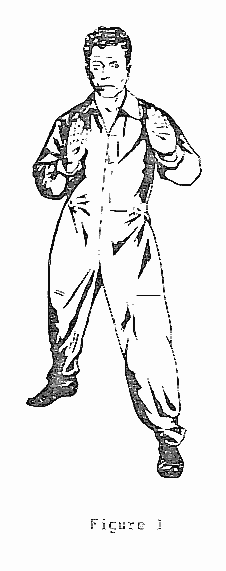
The training which you will receive at this school will give you the
ability to apply the principles of attack and defense, to apply effective
chokes, to defend yourself against chokes and both rear and frontal body
attacks. You will learn the way to use a knife as a weapon and how to defend
yourself against somebody else's knife. You will learn how to deal with
an enemy armed with a pistol or rifle. You will learn to maneuver for control
and how to throw an attacking enemy and apply counters and combinations
in hand-to-hand combat. Above all else you should learn when to attempt
and when not to attempt to use knowledge and skill you will gain.
PRINCIPLES OF ATTACK AND DEFENSE
Objectives
The student will:
Unarmed combative measures might be defined as "the amount of fighting
which, if you are weaponless, is necessary to overcome your attacker."
Since we talk in terms of "maximum efficiency with a minimum of effort,"
we seek to use the measures appropriate to any given situation. In this
lesson we discover the simpler methods of moving and striking which will
take care of many situations. Good body management will move you from the
more dangerous positions in front of your attacker and enable you to counterattack
by providing the opportunity to deliver effective blows to his most vulnerable
areas. In this lesson, you will not only discover which of your attacker's
vulnerable areas will be exposed to you under various types of attack,
but you will also learn which blow will be effective.
Study Assignment
Pages 5-16, SACM 50-10B. [EN1]
Supplementary Information
Americans brought up in the environment of fair play and consideration for others are not normally proficient in disposing of an adversary in a "rough-and-tumble" fight. When it comes to "kill or be killed," you must know how to bring into play measures which you may never have considered before -- in order to preserve your own life. You must be ready to gouge, kick, knee an attacker's groin, and use many other "unethical" forms of attack. You must be ready to crush an enemy's skull or separate his vertebrae with a stamp of your foot. You must be able to use knuckles, fists, and elbows as they have never been used before. When you have the enemy down, don't let him up. Kicking and stamping techniques may be used most effectively in this situation. If you have been knocked down, you should know enough about falling to fall without injury to yourself, and immediately to protect yourself from his boots or other means of attack. The trained person can be very dangerous even when on the ground. (See Figures 2, 3, 4, 5.)
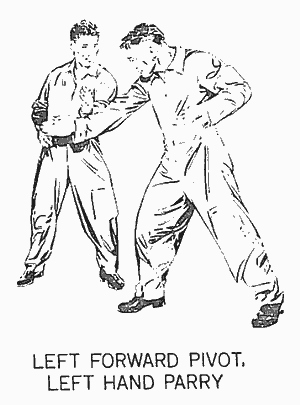
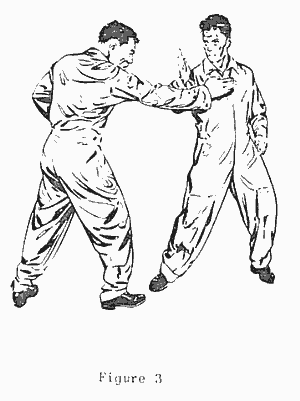
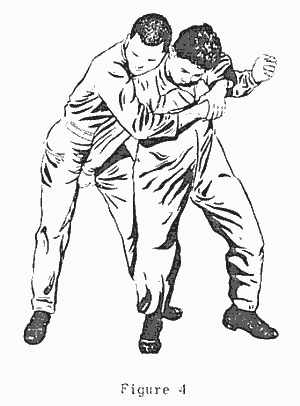
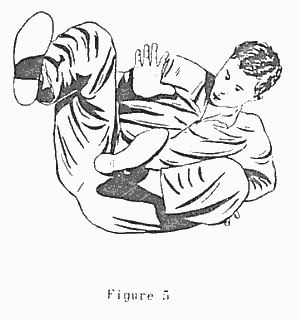
Feet are fine defensive weapons and will keep your attacker at a respectful
distance. If he does attempt to get inside your guard, you can inflict
damage in varying degrees, depending on where you direct your blows. Vulnerable
areas are the kneecap, groin, abdomen, ribs, throat, and face. One important
thing to remember is to fight defensively until you have your opponent
off balance. Give way as your adversary presses to the attack. This should
effect his off-balance. He expects to have his attack resisted, therefore,
he exerts enough force to accomplish his attack. If you "give way" and
do not provide the resistance he expects, you will maintain good balance
while he puts himself in an off-balance position which makes it hard for
him to defend himself.
Question
What is meant by "giving way" under attack, and how will it affect your attacker?
Have you ever seen a person try to force himself into a room when the door is locked? He puts his shoulder to it and pushes. If it doesn't give on the first try, he will again try, using additional force. Now, what would happen if someone unlocked the door and turned the knob just as he was giving it the third try? He would probably charge through and fall on his face! The same principles would apply if you "gave way" under a similar type of attack. Add knowledge of the karate striking techniques of the vulnerable areas, and his helplessness in off-balance position gives you a decided advantage.
The measures you should take when your attacker is off-balance, or when you are in a close quarter fighting situation are predominantly striking techniques. One well-directed blow can save you much struggling. After you have learned the art of body movement and balance, the next step is to learn to inflict damage on your attacker. You will learn how to deliver blows most effectively, and what areas of the body to strike. This training is called "karate." It is derived from an ancient form of fighting originating in the Far East. Here you use your natural weapons. Your hands, feet, elbows, and knees make fine offensive weapons, and they can be an effective deterrent in defense against many types of attack. Evan an attacker wielding a knife, a gun, or a stick can be overcome if you properly apply the principles and techniques which you will learn during this training. (See Figures 5A, 5B.) [EN2]
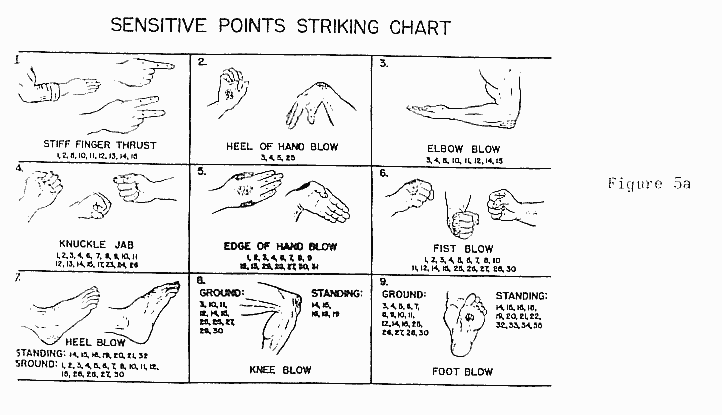
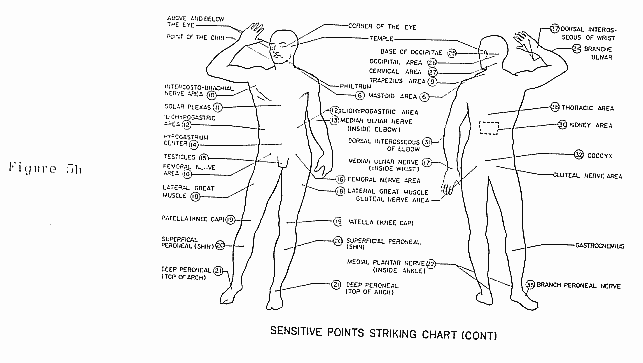
CHOKES AND DEFENSE AGAINST REAR AND FRONTAL BODY ATTACKS
Objectives
The student will:
In hand-to-hand fighting with an enemy, you must expect the dirtiest,
most unethical type of fighting you have ever been exposed to, and you
must be prepared to resort to such tactics yourself. This lesson deals
with the simplest and quickest ways of gaining the advantage over an enemy
regardless of the type of attack he may use. One of the simplest means
of gaining this advantage is to use your foot, knee, or elbow as a weapon.
No matter what type of unarmed attack he makes, he must bring himself within
range of your natural weapons. If he should grab you from behind, for example,
a well placed elbow blow, or a stamp to his shin or arch should force him
to release you. Against close in frontal attacks, a knee blow delivered
to the groin should do the trick. If he should attempt to choke you, these
same
blows can be the means of preventing this action. You will also learn how
to apply many chokes, without exposing yourself to the same dangers your
attacker does when he attempts to choke you.
Study Assignment
Pages 26-41, SACM 50-10B.
Supplementary Information
Choking is one of the most useful methods of disposing of an enemy when it is necessary in an escape or evasion situation. (See Figures 6, 7, 7A.)
A guard or sentry, who is posted well away from camp, can be quietly and efficiently taken care of in this manner, without arousing anyone with excessive noise.
Question
When is it not advisable to attempt to silence a guard with a choke?
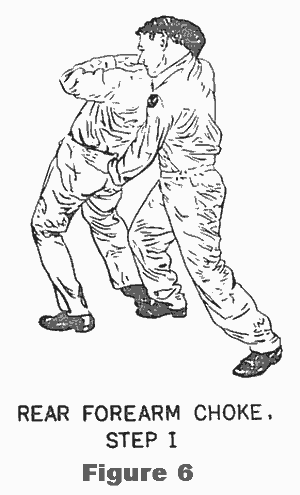
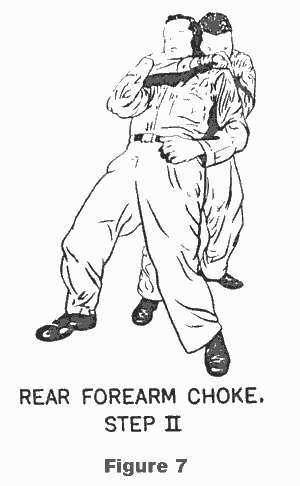
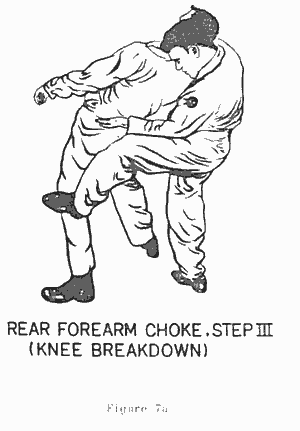
Choking is also effective in hand-to-hand combat. The use of the garrote, collar, and bare arm will provide a man with several choking methods to be used under various situations. With the exception of the garrote, the chokes taught in this course are used in the sport of judo. In judo, they are only used to make your opponent submit. If he doesn't indicate submission in time, he may very well be choked into unconsciousness, as the chokes take effect quite rapidly. In the sport of judo, after a man has been choked, a little resuscitation is all that is necessary for complete recuperation. In combat, however, these same chokes can be used to kill depending on how long the choke is held. When the collar choke or garrote is used, pressure is applied to the carotid arteries of the neck, thereby interrupting the circulation of blood to the brain.
It requires only a few seconds to "black out" a person with this type of choke.
In judo, joint-locking, like the chokes, is another method of getting
your opponent to submit. Application of pressure to the elbow or shoulder
joint will cause immediate submission before the joint can be damaged.
Unlike the chokes, joint-locking causes excruciating pain, and your opponent
will not hesitate to surrender. In the case of hand-to-hand combat with
an enemy, you will not be concerned with making him "give up."
Question
If you succeed in getting a joint-lock on the enemy, what is your next step?
Once in position to apply the lock, apply the force necessary to break
the arm or shoulder. This will severely incapacitate your enemy, and it
is quite possible that the pain will render him unconscious for a time.
You will then be in a better position to take any further measures you
deem necessary to continue your escape.
USE OF AND DEFENSE AGAINST THE KNIFE
Objectives
The student will:
Most aircrew members carry a knife as part of their equipment on combat
missions, but few ever expect to use it as a means of defense and offense
in personal combat. With very little training, a knife can be a formidable
piece of emergency armament. If you find yourself without the regular sidearm,
you may have to rely on your knife. A sentry may have to be taken out,
in order for you to pass a remote post. An unsympathetic enemy civilian
may resent your intrusion and attack with some crude weapon. A knife can
be a real asset in these and similar circumstances.
Study Assignment
Pages 42-54, SACM 50-10B.
Supplementary Information
Although it would be a rare occasion when you must defend yourself against
an enemy armed with only a knife, the possibility is ever present. To prepare
for this eventuality, a portion of this course is devoted to knife fighting.
Naturally a person who is well trained in handling a knife will be a difficult
opponent to cope with. He can, however, be defeated with no other weapons
than your hands and feet. The knife attacker can be held at a distance
and made to respect a safety range by the proper use of kicking techniques.
The length of an outstretched leg is normally quite a bit greater than
that of the extended arm with a knife held in the hand. If the attacker
attempts to press the attack, a few feints in the direction of his extended
knee or groin will slow him down considerably. Scooping up a handful of
dirt and throwing it in the attacker's face will also be a distraction,
and possibly afford the opportunity to counter. Of course, if you can find
a stick of almost any length to aid in your defense, you are in a much
better position to overcome the enemy. The stick can be used both as an
offensive and a defensive weapon. No attacker with a knife can take liberties
with an individual holding even a short stick (fourteen to sixteen inches).
A longer stick would naturally be much more effective. If your only weapon
is a knife, your enemy will have to respect your weapon as much as you
respect his. You should be fighting a defensive battle in any instance.
The object is to make him come off balance by causing him to commit himself
to a definite threat. Your counter will require short slashing movements
at any exposed part of his body, after he has missed his thrust and thus
created the off-balance needed for your advantage.
Question
Since your use of the knife would be primarily defensive, when would be the most opportune time to go on the offense?
If he can be incapacitated, by several slashes to the wrist or leg,
your eventual success is practically assured. Thus, with your defensive
knife fighting, you are looking for one of two situations to present itself:
One, the opportunity to incapacitate him with your defensive counter slashes;
two, finding him completely off balance by his lunge so that he is momentarily
defenseless. In either of these situations, he can be considered "ready
for the kill."
USE OF AND DEFENSE AGAINST A PISTORL OR RIFLE
Objectives
The student will:
An enemy soldier or guard holding you at gunpoint will make several mistakes, unless he is well trained in handling prisoners. One mistake on the enemy's part is all that is needed to enable a trained individual to successfully disarm the soldier or guard. The impatient guard can give you the opportunity for action when, to get you to move faster, he prods you in the back with his weapon. Or the gloating, over-confident captor may give you the opportunity when he sticks his weapon in your stomach to accentuate his orders. However, these instances may be rare. You must try to induce the wary guard into committing the one blunder which you can use to best advantage. The trained person is much harder to cope with because he will usually maintain a discreet distance. Disarming a person who holds a gun on you is always dangerous; nevertheless, it can be done with a better than even chance for success, if you choose the proper psychological moment. (See Figure 8.)

Study Assignment
Pages 55-63, SACM 50-10B.
Supplementary Information
Usually the enemy soldier who confronts you will be armed with a pistol or rifle. An untrained person, because he lacks confidence, normally considers this a hopeless situation and resigns himself to his fate. A trained individual, however, is already in the process of evaluating the situation and figuring his chances of escape. At the first command, he knows enough to give way by obeying all orders quickly; he is also aware of the safety range, line of fire, and anything else about his captor that may give him an idea of how he can effect an escape. He is alert (See Figures 9-10) and waiting for the psychological time to act, and has concentrated his gaze on the eyes of his captor. Your captor's eyes will normally be a clue to his next move.
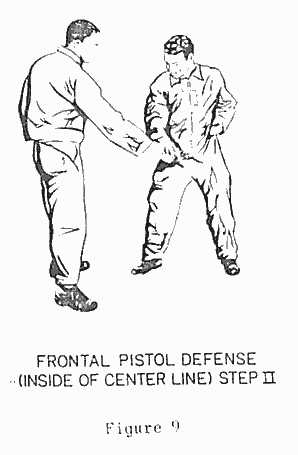
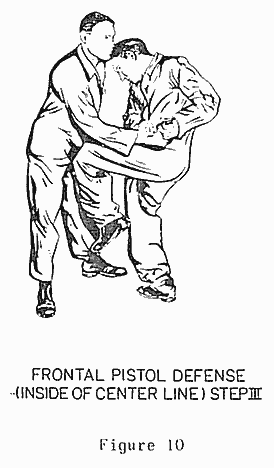
As long as his gaze is fixed on your upraised arms or in that general
vicinity, he is alert for any move you may make. This is not the time to
attempt to disarm him. The psychological time to act is at that moment
when he takes his eyes away from their original focal point. At this time,
you captor's mind is not on you or your possible intentions, but on the
object of his gaze -- your weapon or your pockets. He is not concentrating
on the pulling of the trigger. If it is your gun he wants, or something
in your pockets, his mind is occupied with these thoughts. It is well known
that the mind cannot maintain two separate thoughts with equal concentration,
therefore, when he is looking at the weapon in your holster or your pockets,
his mind is not on the gun in his hand, much less on squeezing the trigger
if you move. So when his eyes turn away from their original focal point,
it is time for you to make your move, providing of course, the safety range
is adequate. You know exactly what you are going to do, he does not. By
the time he is aware of your movement, he must do several things. He must
recover from the sensation, then interpret what has taken place, and finally
pull the trigger. All this takes time, probably more time than it will
take you to move your body out of the line of fire as you deflect the weapon,
and use whatever follow-up is necessary.
Question
What is meant by "psychological timing"?
In an attempt to disarm a person who has a pistol or rifle pointed at
you, it is particularly important to evaluate the line of fire. The direction
in which you move is dictated by the direction in which the weapon points
in relation to your body. If the weapon is centered on your body, the direction
(left or right) you choose is optional. However, if the weapon is pointed
to your right side, your chances will be much better if you move your body
to the left. This cuts down the amount of time your body is exposed to
the weapon as you move out of the line of fire. For example, assume that
the body is twelve inches across. If the weapon were pointed at the middle
of the right side of your body and you moved to your right, nine inches
of your body would pass the muzzle, whereas if you moved to the left, only
three inches would be exposed to the muzzle. In other words, if you moved
in the wrong direction, your body would be exposed to the line of fire
three times as long as it would have been if you had moved properly.
Question
What is meant by the "line of fire"?
"Safety range" has been mentioned several times. The term should be
clarified at this point. "Safety range" is that distance from the weapon
(be it a knife, gun, stick or anything else) which permits you to act with
a definite margin of safety. If you are to attempt to disarm a person holding
a pistol or rifle on you, his weapon must be close enough that you can
reach it with a minimum of forward motion. If the weapon is behind you,
you must feel it poking into your back before it is advisable for you to
attempt disarming. If you can feel the weapon in your back, you know where
it is. If you can't feel it, you do not know whether it is one inch or
several feet from you. If a knife is the weapon your attacker is wielding,
the safety range is different. Here, you should keep several feet between
you and your attacker. If you are close, he can cut you without too much
effort on his part. If you are six feet or more away from him, he will
have to lunge to reach you. This gives you time to move out of the line
of his thrust and be ready to take whatever counter-measures are necessary
to dispose of your attacker.
THROWS, COUNTERS, COMBINATIONS, AND MANEUVERS FOR CONTROL
Objectives
The student will:
Throwing is a simple way of using your attacker's momentum and strength
to your advantage. There is no mystery involved in the fact that a 100
pounder can throw a 200 pounder with no apparent effort. The law of physics
regarding inertia is the "big secret." Since a body in motion tends to
remain in motion, it only requires a little redirection of this motion
to cause the person "in motion" to lose balance and fall. When you throw
an opponent, you not only inflict serious injury as a result of his contact
with the ground, but you are also in a position to control him as he lies
on the ground and to use any other measures you may deem necessary at the
time.
Study Assignment
Pages 17-20, SACM 50-10B.
Supplementary Information
In a judo contest, it is fairly difficult for a man to throw his opponent
if the skills of the two are relatively equal. The greater the skill differential,
the easier it becomes for the one to throw the other. In hand-to-hand fighting,
however, it requires very little skill to be able to throw an opponent.
This is due to the element of surprise. In the first place, your enemy
is not aware of your capability nor of your intention to throw him. Secondly,
he is too intent on what he is trying to accomplish to use good judgment.
Again, you should be fighting defensively to set up the right off-balance
situation. As he pushes you, he is off balance to the front and can be
thrown in this direction if you use his momentum to your advantage. By
the same token, if he is tugging or pulling at you, he is off balance to
the rear. Your throwing effort should be in the rearward direction. Knowing
the fundamentals of a few throws, and an understanding of the principles
involved, makes throwing an unsuspecting attacker fairly easy.
Question
In what direction would you throw a person who was starting to swing at you?
Two examples of practical throwing methods are illustrated in the accompanying drawings. In Figure 11, the aircrewman being attacked has been pushed backward. He has immediately given way under the force of his attacker's forward motion. By grabbing the attacker's arms and lowering his own body to the ground, the aircrewman has increased the attacker's momentum and redirected his force. Now the attacker is off balance and cannot stop his formward movement. As the airman rolls on his back he brings his right leg up into the groin of his enemy and continues to pull on the enemy's arms. His attacker will continue to move over airman's body. By continuing to hold his attacker's arms, the aircrewman will cause him to "flip over" to land on his head or back and suffer some injury or at least be "shaken up" considerably. This should make the enemy easy prey for the follow up.

In the second example, Figures 12, 13, 14, the off balance is to the rear. The crew member has been attacked from behind. By quickly "giving way" (in this case backing up quickly as the attacker pulls) the attacker has been off-balanced. He did not expect this reaction (non-resistance) to his pull. Now, as the attacker loses his balance the aircrewman quickly makes a half pivot and places a leg behind the enemy. This action alone would probably cause the attacker to fall backward. However, to insure the fall and maintain complete control of the action, both legs of the attacker are grabbed at the knees and raised in a scooping motion. If the enemy continues to maintain his grasp, the airman need only drive the enemy into the ground by falling on him. The landing should be pretty rough on the attacker, and the aircrewman is in good position to deliver destructive hand, elbow, knee, or foot blows depending on his own position when the attacker hits the ground. (See Figure 14.) One of the main points to remember in considering the use of throwing techniques is that the attacker expects you to resist his efforts in the accepted way, with resistance. If you "give way" and do not supply the resistance he is expecting, he is momentarily off balance, both mentally and physically. This is your opportunity to throw, and remember, always throw in the direction of his off-balance.

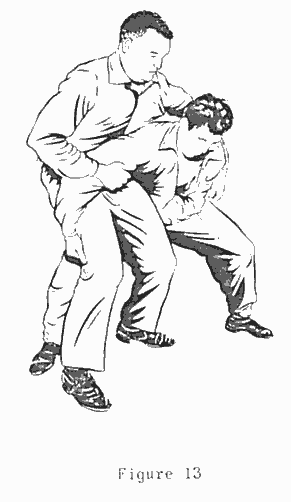
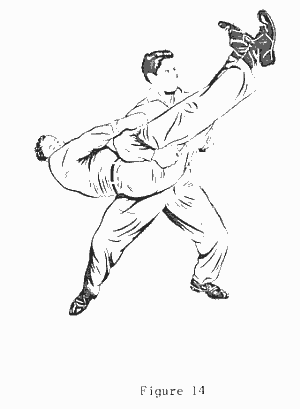
In every situation, it is most advisable to get your opponent off balance
before going on the offensive. His off-balance renders him ineffective
in his own defense. Your balance permits you to counterattack without any
delay or lost motion. Guards or sentinels can be taken out effectively
through the use of choking techniques. However, it may not be advisable
to apply these techniques to security personnel in or around an enemy's
prison camp. In such situations attacks on these individuals would result
in reprisals against your fellow prisoners and you. Any escape from a POW
camp involving disabled or dead guards would only serve to lessen your
chances of effecting your ultimate escape. They would be missed from their
posts too soon to afford you sufficient time to get far enough away from
the camp. With the whole countryside alerted, your chances would be pretty
slim.
REVIEW AND TEST OF AIRCREW SELF-DEFENSE TECHNIQUES
Objectives
The student will:
In the review of all critical items, you will have an additional opportunity
to practice techniques and refresh your memory. Speed will not be essential
for the test since the emphasis is placed on the mechanics of the techniques
being evaluated.
Study Assignment
Pages 1, 2, 64-85, SACM 50-10B.
Supplementary Information
There is no intention to make gun disarming or any other phase of this
training sound easy to perform. Many things must be considered. The element
of surprise, for example, is of the utmost importance. Without it very
little can be accomplished. No one will willingly permit himself to be
kicked, choked, or disarmed. This must be accomplished through surprise.
EDITOR'S NOTES
EN1. Although other Air Force manuals will be added to Journal of Non-Lethal Combatives over time, SAC Manual 50-10B is not presently available. Anyone who has a copy is therefore requested to contact the editor at jrsvinth@juno.com.
EN2. For more detailed information about anatomical targets, see Joseph R. Svinth, "Targets," http://ejmas.com/jnc/jncart_svinth6_1199.htm.